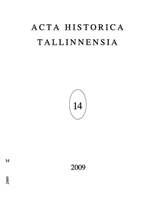ÜLERIIKLIKU TEKSTIILITÖÖSTURITE ÜHINGU TEGEVUS TEKSTIILITÖÖSTUSE EDENDAMISEL AASTAIL 1936–1940
THE ACTIVITY OF THE ESTONIAN TEXTILE MANUFACTURERS’ ASSOCIATION IN THE DEVELOPMENT OF THE TEXTILE INDUSTRY, 1936–1940
Author(s): Maie PihlamägiSubject(s): History
Published by: Teaduste Akadeemia Kirjastus
Keywords: Estonia; Estonian History; ESTONIAN TEXTILE MANUFACTURERS’ ; DEVELOPMENT OF THE TEXTILE INDUSTRY ; 1936–1940
Summary/Abstract: The textile industry was the most important branch for the Estonian industry. It gave 20–31% of the total industrial production and employed 20–25% of the total industrial workforce. After the great depression the protectionist policy relaxed and the textile industry faced in the home market growing competition from major textile-producing countries, primarily England and Germany, but also from new Estonian textile manufacturers, who followed the changes in fashion. The growing labor movement for better working conditions and higher wages diminished the employers’ position in the labor market. The changed economic environment and strengthened labor movement were the main reasons for textile entrepreneurs to organize and establish the Estonian Textile Manufacturers’ Association in summer 1936. // The association was a voluntary non-profit organization of individuals engaged in textile production. The main goals of the association were to promote the development of the textile industry and to represent and protect the common interests of Estonian textile entrepreneurs. The association was a member of the International Wool Textile Organization; also close contacts were established with textile manufacturers’ associations in England and Sweden. The members of the Estonian Textile Manufacturers’ Association represented over 31 enterprises with more than 11 000 employees (ca 85% of the persons engaged in the textile industry). The organization lobbied actively for pro-business interests, especially for a tax cut, low custom tariffs of raw materials and protection of the textile industry by customs, also against government attempts to monopolize the flax trade. The association took part in the work of the committees of the Ministry of the Economic Affairs and expertized on several economic matters. This clearly indicates that the Estonian government accepted the association as an equal partner. // The association stimulated the rationalization of the textile industry to promote industrial development, profitability and competitiveness. It explained to the members the ideology of rationalization, helped solve the problems and consulted in this matter. However, in practice employers expected to achieve an increase in productivity mostly by increasing work intensity. At the same time the modernization of production methods, equipment and machines was neglected. // In cloth-mills and cotton factories attempts were made to raise productivity by having one weaver tend 6 looms instead of 3–4 looms. Also the introduction of the Bedaux system, inspired by Taylor’s Scientific Management and based on time studies, was under discussion on board meetings, but this system of rationalization never came into widespread use. As the faster work was not reflected in the rate of wages, rationalization met opposition from workers. // The organization helped bridge the gap between the textile industry and textile education promoting the education in this area.
Journal: Acta Historica Tallinnensia
- Issue Year: 2009
- Issue No: 14
- Page Range: 102-124
- Page Count: 23
- Language: Estonian

